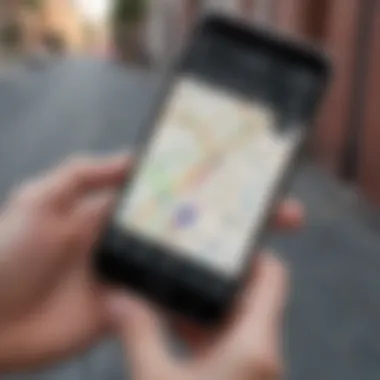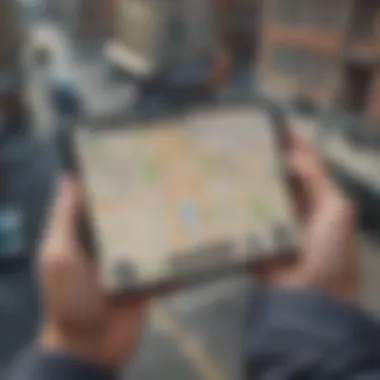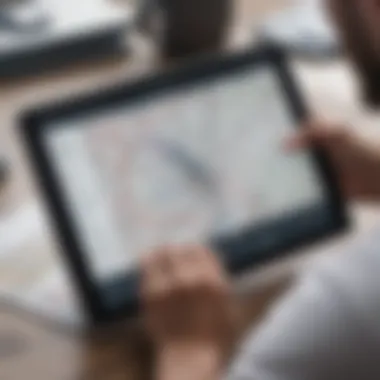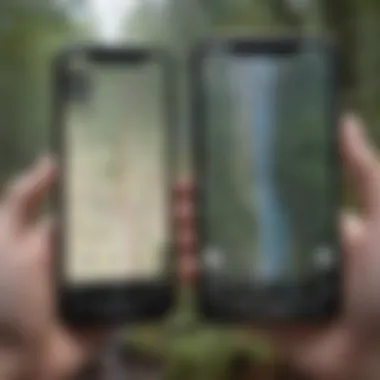Top GPS Coordinate Apps for Accurate Navigation


Intro
In today's world, having accurate location information is crucial for various activities ranging from travel to everyday navigation. GPS coordinates play a significant role in ensuring pinpoint accuracy, which can be invaluable for tasks such as mapping, exploration, and even emergency situations. This guide provides an extensive overview of the best applications available for Android devices that specialize in obtaining and utilizing GPS coordinates.
These applications are designed not just for basic navigation but also for location sharing, geolocation analysis, and other nuanced features that enhance user experience. As more individuals and businesses rely on GPS functionality, it becomes imperative to choose the right apps that align with one's unique needs and objectives.
This article aims to present distinctive features, usage scenarios, and comparative advantages of top GPS apps. By the end, readers will have the knowledge necessary to make informed choices tailored to their specific requirements for navigation and geolocation accuracy.
Preamble to GPS Coordinates Apps
GPS coordinates apps are increasingly integral in our everyday lives. They are not just a tool; they are a pathway to understanding our environment and making informed decisions about travel, exploration, and even safety. Given the constant development in GPS technology, knowing how to leverage these apps effectively is essential.
Understanding GPS Technology
Global Positioning System, or GPS, relies on a network of satellites orbiting the Earth. These satellites transmit signals that GPS devices and apps use to pinpoint locations accurately. By calculating the time it takes for signals to travel from satellites to a device, the application can determine the exact coordinates—latitude and longitude—of a given location.
The development of GPS technology has experienced dramatic advancements, leading to an increase in their application. Modern GPS systems are not only precise but also enhanced to work effectively in various conditions, like urban areas with tall buildings or rural settings without much infrastructure. Users can now receive real-time data, making navigation smoother and significantly reducing the chances of getting lost.
Importance of Accurate Coordinates
Accurate coordinates hold immense significance across numerous domains. For navigation, having precise coordinates can dramatically affect travel times and efficiency. In geospatial analysis, incorrect data can lead to skewed results, impacting decision-making in fields like urban planning or disaster response.
Getting the right coordinates is essential for location sharing as well. Whether you are meeting a friend or need emergency assistance, sharing accurate GPS data helps avoid miscommunication. The benefits of precise GPS coordinates extend beyond personal use. Businesses that depend on logistics or delivery services require exact coordinate data to ensure timely and efficient operations.
In summary, as GPS technology evolves, the importance of understanding and utilizing GPS coordinates apps cannot be underestimated. Awareness of the capabilities and nuances of these applications empowers users to maximize their potential in various contexts.
Criteria for Evaluating GPS Apps
Evaluating GPS applications requires a systematic approach. With a multitude of options available, discerning the right app for specific needs is critical. Users should consider various elements that affect both functionality and user experience. This section explores essential criteria: user interface and usability, features versus functionality, and compatibility with devices. Each aspect impacts how effectively an app can serve its intended purpose.
User Interface and Usability
User interface is a vital element of any GPS application. A clean, organized layout helps users navigate through features quickly. Intuitive designs allow users, regardless of tech-savviness, to operate the app efficiently. Consider a map interface that displays information clearly without overwhelming the user. Easy access buttons for common tasks, such as saving locations or sharing coordinates, can enhance the overall experience.
This aspect is not simply about aesthetics; it also affects usability. A well-designed app can significantly contribute to user satisfaction. Therefore, when evaluating a GPS app, prioritize how user-friendly the interface is along with its design.
Features and Functionality
Feature sets in GPS applications vary widely. Some users may prioritize basic navigation features, while others seek advanced functionalities, such as offline access or route optimization.
Important features to consider include:
- Navigation Efficiency: The app should provide accurate and timely directions.
- Location Sharing: The ability to share coordinates easily with others adds value for users.
- Customization Options: Users appreciate the ability to personalize their experience.
- Offline Capabilities: This is crucial in areas with poor internet connectivity.
By examining the features against your needs, one can gauge the app's effectiveness. The right combination of features can significantly enhance user experience by making navigation more efficient.
Compatibility and Performance
Compatibility is essential for ensuring that the GPS app functions across different platforms and devices. Users often switch between devices, hence, an app should sync seamlessly. Consideration should also be given to how the app performs under various conditions. Does it work well in rural areas with limited signal? How quickly does it respond to inputs? These performance metrics are critical for real-time activities, such as navigation.
Evaluating app performance may involve reviewing user feedback and expert opinions. Ensuring an app meets acceptable response times and stability can save users from frustrating experiences when they rely on GPS functionalities.
In summary, evaluating GPS applications should revolve around a thorough understanding of user interface, feature sets, and compatibility. These criteria not only enhance the user experience but ultimately guide users to select the most suitable app for their navigation and coordinate needs.
Top GPS Coordinates Apps Overview
The availability of numerous applications for GPS coordinates highlights the necessity of understanding their individual features, benefits, and limitations. Users frequently rely on these apps for navigation, location sharing, and geospatial services. The diverse capabilities of different apps cater to a range of audiences, including casual users and professionals. Knowing what each app offers can greatly enhance the effectiveness of navigation operations and coordination tasks.


In this section, we will review standout applications, such as Google Maps, Waze, MAPS.ME, Here WeGo, and various geocaching apps. Each app serves unique functionalities that can align with the user’s specific needs. We will discuss essential aspects, advantages, and possible shortcomings of these applications, aiming to provide comprehensive insights.
Google Maps
Key Features
Google Maps stands as a frontrunner in providing users with comprehensive navigation options. Its key features include detailed satellite imagery, street views, and routes for various modes of transport. The emphasis on accurate real-time traffic information makes Google Maps a popular choice among commuters. The ability to receive alternative route suggestions also enhances its overall utility. However, the reliance on mobile data can limit usability in remote areas without connectivity.
Usage Scenarios
This app excels in a myriad of scenarios, from casual city navigation to extensive road trips. Users find it beneficial for efficiently exploring new locations or avoiding traffic. Furthermore, integration with Google services facilitates smooth access to information regarding nearby restaurants or points of interest. Yet, the heavy resource usage can be a drawback for users with limited data plans.
Advantages and Limitations
Google Maps offers a wealth of advantages, such as extensive global coverage and compatibility with various devices. One unique feature is the offline map availability, which allows for navigation without constant data access. However, the app does have limitations such as occasional inaccuracies in rural areas and dependence on user-generated data, which may not always be reliable.
Waze
Real-Time Navigation
Waze distinguishes itself by offering real-time navigation that adapts to current traffic conditions. Users receive timely updates on road hazards, delays, and recommended detours. This real-time functionality results in optimized travel routes and significant time savings. One downside is that the user interface can become cluttered, particularly with community-generated alerts.
Community Features
Waze incorporates community features that encourage user interaction. The ability for users to report traffic conditions, accidents, and police presence fosters a sense of collaborative navigation. This feature is appreciated by many, yet it may lead to information overload for users who prefer a more simplified interface.
Comparative Analysis with Google Maps
When comparing Waze with Google Maps, it becomes clear that each app has its strengths. Waze’s real-time updates are superior, while Google Maps shines in its overall user experience and extensive search capabilities. Additionally, Waze focuses more on driving efficiency, while Google Maps promotes general exploration. This recognition of strengths aids users in selecting the appropriate app according to their specific needs.
MAPS.ME
Offline Capabilities
MAPS.ME stands out with its robust offline capabilities. Users can download detailed maps of various regions to access them without needing an internet connection. This utility is essential for travelers or individuals in areas with limited network service. However, without periodic updates, the maps can become outdated.
Customization Options
Customization within MAPS.ME is a notable feature. Users can adjust map layers to highlight points of interest or amenities, enhancing their navigating experience. Yet, the customization options may not be extensive enough for advanced geospatial users.
Targeted User Base
This app is particularly geared towards outdoor enthusiasts and travelers who prefer navigation without online constraints. While this targeted focus presents significant advantages, such users may find limited functionality in urban environments where other applications might be more suitable.
Here WeGo
Integration with Public Transport
Here WeGo excels in offering integration with public transport systems, making it a preferred app for city dwellers. Users appreciate the ability to plan routes using a combination of walking, cycling, driving, and various public transit options. Despite its strengths, some users report usability issues in less populated areas where public transport data may not be comprehensive.
Mobile Data Requirements
Although Here WeGo can function offline, it requires initial map downloads, which may consume significant mobile data. This necessity can deter potential users with limited data plans or reliance on mobile connectivity in real-time travels. It’s essential for users to consider their data usage habits before committing.
User Experience Insights
User interface insights suggest that Here WeGo is clean and straightforward. Its design prioritizes ease-of-use, but some advanced functionalities may be overlooked by average users. Furthermore, the visual representation of data is well executed, though it may not offer the same level of detail as competitors like Google Maps.
Geocaching Apps


Exploration and Adventure
Geocaching apps ignite a sense of exploration and adventure among their users. They facilitate outdoor treasure hunts using GPS coordinates, appealing to adventurers and families alike. However, because of their niche focus, they may not cater to users looking strictly for navigational purposes.
Community Engagement
The community engagement aspect is vital in geocaching apps. Users connect with others who share similar interests, promoting social interaction and collaborative treasure hunts. However, the reliance on user submissions for location accuracy can sometimes lead to discrepancies.
Unique Features
Geocaching apps often possess unique features such as the ability to record finds, earn badges, and participate in challenges. These gamified elements enhance user experience, although some users may prefer a more straightforward navigation-focused app without such distractions.
Understanding these apps offers essential insights for making informed choices tailored to specific navigation needs. This section aims to provide clarity on the multifaceted landscape of GPS coordinates applications.
Specialized Apps for Professional Use
Specialized apps for professional use play a significant role in enhancing efficiency and accuracy in various fields, including surveying, agriculture, and construction. These applications cater to the needs of professionals who require precise GPS data to perform tasks effectively. The features these apps offer often go beyond typical navigation functions, facilitating specialized operations tailored to particular industries. Understanding the distinct advantages and potential limitations offered by these applications is essential for professionals aiming to utilize GPS technology to its fullest extent.
Field Access GPS
Target Audience
The target audience for field access GPS apps typically includes geologists, land surveyors, agronomists, and environmental scientists. These users prioritize precision and reliability in location data, often relying on GPS coordinates for field research and other professional tasks. Their work usually involves accessing remote areas, making a robust GPS tool crucial.
The specialized needs of this audience contribute to the popularity of these apps as they provide features specifically designed for data collection and analysis. Unique features may include high accuracy levels, offline data storage, and integration with other professional tools. One notable advantage is their emphasis on functionality in rural or hard-to-reach environments, an essential trait for professionals working outside urban settings.
Features for Professionals
Features specifically designed for professionals often include high-resolution mapping, real-time data collection, and customizable data fields. These tools are beneficial due to their ability to compile extensive datasets crucial for analysis. Professionals can track environmental changes, assess land characteristics, and monitor agricultural practices effectively.
Furthermore, these apps may offer capabilities like exporting data in various formats, which is vital for integration with other software used in research and reporting. A potential disadvantage could be the complexity of some features, which may require training to use effectively, potentially complicating initial adoption for new users.
Usage Examples
Typical usage examples for field access GPS apps include land surveying for construction projects, precision farming in agriculture, and monitoring ecological conditions in environmental studies. Professionals rely on these applications to produce accurate geographical representations and track changes over time. For example, surveyors utilize these tools to map out property boundaries and prepare construction sites, demonstrating how integral these apps become in day-to-day operations.
The customizable nature of these apps allows professionals to adapt their usage based on specific project requirements, enhancing their overall effectiveness. However, users may face challenges when dealing with different terrain types or extreme weather, which could impact GPS signal strength, leading to potential inaccuracies.
GIS Applications
Geographic Information Systems Basics
Geographic Information Systems (GIS) are essential tools that manage, analyze, and visualize spatial data. They enable users to understand relationships between different variables across geographic contexts. The importance of GIS lies in their ability to combine various data types to produce comprehensive analysis and insights.
Understanding GIS basics informs users about the functionalities of these systems, highlighting their significance in professional settings. A unique feature of GIS applications is their capability to layer multiple data sources from satellite imagery to demographic information, providing users a multidimensional perspective. This richness in data can lead to better decision-making processes but may require significant resources to process and manage.
Popular GIS Tools
Several popular GIS tools, such as ArcGIS and QGIS, offer various features tailored for professional use. These tools help experts in urban planning, resource management, and transportation logistics to create detailed visualizations of spatial data. Their significance stems from their powerful analysis capabilities, allowing professionals to produce maps and reports that enhance planning and operational strategies.
However, an essential consideration is the learning curve associated with these tools. Users may require training to utilize all available features fully, which can initially deter some professionals from adopting them.
Advantages for Data Analysis
The advantages of using GIS tools for data analysis are manifold. They provide insights from spatial data, enabling professionals to identify patterns and trends that may not be apparent through traditional analysis. The ability to visualize complex data sets aids in presenting findings clearly to stakeholders and contributing to informed decision-making.
Moreover, GIS applications often support real-time data integration, facilitating agile responses to changing conditions in fields like urban management and disaster response. Despite their benefits, users should be cautious about data quality and accuracy, ensuring that the datasets used in analysis are reliable and up-to-date.


Emerging Trends in GPS Technology
The landscape of GPS technology is constantly evolving. As users become more reliant on accurate location data, it is essential to stay abreast of emerging trends. These trends can significantly impact how we interact with GPS applications. By understanding these advancements, users can make better decisions about which technologies to adopt and how to utilize them effectively in both personal and professional contexts.
Augmented Reality Navigation
Augmented reality (AR) navigation is one of the most fascinating advancements in GPS technology. This trend enhances traditional navigation methods by overlaying digital information onto the real world. It utilizes your smartphone's camera to provide a visual guide to directions. As a result, users can see their walking route overlaid on their surroundings in real time. This can enhance situational awareness and reduce the chances of getting lost.
Additionally, AR navigation is particularly useful in complex urban environments. Users can quickly identify points of interest, such as restaurants or stores, with additional context provided by the app. The technology also has potential applications in areas like tourism and events, where immersive experiences can enhance user engagement. However, a key consideration is the need for significant processing power and high-quality camera functionality in smartphones to run these applications smoothly.
Integration with IoT Devices
The integration of GPS technology with Internet of Things (IoT) devices represents another crucial trend. This development can streamline various functions across multiple domains, including smart homes, vehicles, and wearable technologies. For example, smart devices can share location data to improve efficiency and convenience.
In automotive applications, GPS integrated with IoT can enable smarter route planning, vehicle tracking, and even automated driving features. Wearable devices can track fitness activities accurately using GPS data, allowing for better health monitoring.
However, with this growing integration comes the challenge of ensuring user privacy and data security. As more devices become interconnected, the potential for data breaches increases. Users must be aware of the implications of sharing their location data with multiple devices, putting a premium on selecting trustworthy applications.
"The future of GPS technology hinges on integration and data accuracy, but we must prioritize user privacy alongside these advancements."
In summary, staying informed about trends like augmented reality navigation and IoT device integration is vital for users who seek to maximize the potential of GPS technology. The future holds exciting possibilities that promise to enhance navigation and location services if managed responsibly.
User Privacy and GPS Tracking
In the current digital landscape, where data is constantly collected and analyzed, the topic of user privacy concerning GPS tracking has becoming increasingly important. Many GPS applications utilize location data to offer enhanced features. However, this also raises several concerns surrounding user privacy.
Understanding the delicate balance between harnessing the benefits of GPS technology and maintaining individual privacy rights is crucial. Users must be aware of how their data is being used, the extent of the tracking, and the potential risks involved. Awareness of these issues is key to making informed decisions about which GPS applications to use and how to configure them.
Data Collection Issues
GPS applications typically rely on data collection to provide accurate navigation, location sharing, and other essential functionalities. Here are some significant data collection challenges users should understand:
- Personal Information Leakage: Many apps ask for user consent to collect not just location data but also personal details. This can include contact lists, photos, and social media information. Users should scrutinize apps regarding what data they really need to function.
- Data Retention Policy: Different apps have varying policies about how long they store user data. Understanding these retention practices is crucial. Some apps may keep location history indefinitely, which can lead to privacy concerns down the line.
- Consent Management: Users often consent to data collection without fully understanding the implications. It's important to read through privacy policies and understand the terms before user acceptance.
"User awareness and proactive management of data choices are the foundation of true privacy protection."
Best Practices for Privacy Protection
To mitigate risks associated with GPS tracking, users should adopt certain best practices that promote privacy protection:
- Review Permissions Regularly: All smartphone operating systems allow users to manage app permissions. Regularly check what permissions each app has, especially for location services.
- Use Anonymous Mode: Many GPS apps have options for anonymous or private modes. Utilizing these modes can limit the amount of data shared and may not log location history.
- Limit Background Location Access: Disable background tracking for apps that do not require constant location access; this lessens the chance of unwanted data collection.
- Opt for Trusted Apps: Research and choose well-reviewed applications known for prioritizing user privacy. Look for apps that offer transparency about their data policies.
- Stay Updated: Regularly update apps and the operating system. Updates often come with improved security features that protect user data.
By following these practices, users can better protect their privacy while still benefiting from the advantages offered by GPS applications.
Closure and Future Outlook
The exploration of GPS applications reveals their vast potential and importance in today's technology-driven world. Maximizing the utility of these apps is crucial, as it can significantly impact navigation efficiency and general location awareness. By utilizing the wide array of tools at their disposal, users can harness GPS capabilities for various applications ranging from mundane commutes to complex geospatial analyses.
Maximizing Utility of GPS Apps
To make the most of GPS applications, individuals should first assess their specific needs. Different functions such as real-time navigation, offline maps, and geocaching are vital to certain user profiles. Users should prioritize applications that align directly with their habits and requirements. Here are some recommendations for maximizing effectiveness:
- Explore Settings: Adjust application settings to suit personal usage patterns. This could include customizing map preferences or toggling location accuracy options.
- Integrate with Other Tools: For enhanced functionality, users can integrate GPS apps with other services like calendar apps or social media platforms. This makes sharing locations or planning events more seamless.
- Stay Updated: Regularly check for application updates to ensure access to the latest features and improvements. New updates often include better user interfaces and enhanced performance.
By focusing on these strategies, users can effectively utilize GPS applications, leading to improved navigation experiences.
Anticipating Future Developments
The trajectory of GPS technology suggests significant advancements in accuracy and user experience. As artificial intelligence and machine learning continue to evolve, GPS apps will likely incorporate more predictive elements. This means that navigation could become even more intuitive, helping users navigate not just paths, but also real-time traffic conditions and potential hazards.
Other aspects to consider in the future of GPS applications include:
- Enhanced Privacy Features: With increased awareness around data protection, future developments may emphasize stronger privacy controls within GPS services. This could help users manage data collection and sharing practices more effectively.
- Improved Geospatial Analysis Tools: More sophisticated tools for data visualization and analysis will likely emerge, catering to both casual users and professionals.
- Integration with Broader Ecosystems: As the Internet of Things continues to expand, GPS applications could serve as integral components in smart homes and urban planning utilities.
In summary, the future outlook for GPS applications is promising. As technology advances, users will gain access to increasingly sophisticated tools that can adapt to their needs, making navigation and location-based services more efficient and less intrusive.



